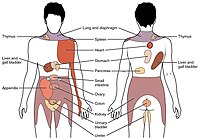
Photo from wikipedia
Objective: The purpose of this study was to assess the effect of continuous compression stimulation on pressure‐pain threshold and muscle spasms in older adults with knee osteoarthritis. Methods: Thirty‐two older… Click to show full abstract
Objective: The purpose of this study was to assess the effect of continuous compression stimulation on pressure‐pain threshold and muscle spasms in older adults with knee osteoarthritis. Methods: Thirty‐two older adults with knee osteoarthritis on outpatient visits were randomly divided into 2 groups. Those in the treatment group (n = 16) received 5‐minute massage therapy (continuous compression stimulation), and those in the control group (n = 16) received sham massage therapy (touch without compression). Immediately before and after single‐intervention sessions, the pressure‐pain threshold, muscle spasm, and pain were quantified. Results: The change in pain on walking in the treatment group exceeded 1.9 cm, corresponding to the minimum clinically important difference. In the treatment group, the pressure‐pain threshold improved significantly for pain both at rest and while walking, but the improvement in muscle spasm was not significant. Conclusions: Massage therapy resulted in minimal clinically important changes for pain relief. There was an increase in the pressure‐pain threshold in the older adults with knee osteoarthritis. We propose that the improvements in pain may be related to the medial thigh muscle rather than knee osteoarthritis.
Journal Title: Journal of Manipulative and Physiological Therapeutics
Year Published: 2018
Link to full text (if available)
Share on Social Media: Sign Up to like & get
recommendations!